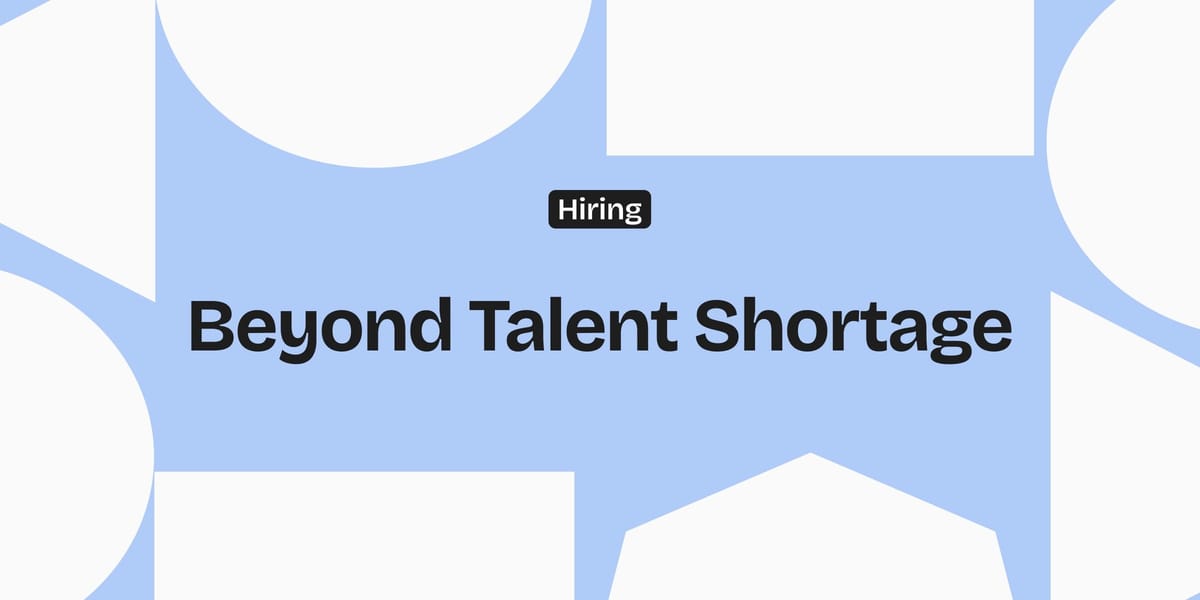The Myth of the Talent Shortage
The myth of a talent shortage hides the real issue: gaps in how we hire. By fixing HR screens, tech rounds, and culture, leaders can unlock stronger teams.

Nobody is hiring for the “average programmer.” Every company wants the top 1%. Think about it: how many CVs land in your inbox every month? How many do you actually interview? How many do you hire? And even after all that filtering, how often are you genuinely happy with the people you picked?
There’s no shortage of developers. There’s a shortage of developers you actually want on your team. And that’s not a talent problem. That’s a hiring problem.
Hiring today feels like a funnel gone wrong. Thousands of resumes, keyword-based HR screens, endless tech rounds, and still the wrong people slip through. Companies confuse this with scarcity, but it’s not scarcity. It’s broken systems.
Rethinking Hiring
I’ve written before on why hiring is broken. That post set the stage for this one — the myth of the shortage is just another symptom of the same broken systems.
If the shortage is a myth, the real question is: how do we fix the system?
Empowering HR with sharper tools
Most HR filters are stuck in the past. They scan for keywords, job titles, or brand-name companies, but that misses the real signal. At Hawk Martech, we started equipping HR with structured questions that measure basics and confidence. Instead of just passing candidates based on fancy words, HR could now identify if someone actually understood loops, conditionals, or had confidence in explaining their own work. One of our recruiters once told me she felt like she finally had a steering wheel. That simple shift cut out a huge amount of noise. Engineers stopped wasting hours interviewing people who couldn’t code their way out of FizzBuzz. It also gave HR a sense of ownership in the process, making them true partners instead of just gatekeepers.
What to look for in a candidate
Great engineers are not puzzle solvers, they’re problem solvers. You spot them when they start asking questions no one else in the room thought of. They don’t just answer, they clarify requirements, think about edge cases, and weigh trade-offs. In one interview, a candidate paused halfway through and asked, “Wait, what constraints are we under here?” That single question told me more than a polished solution. On the flip side, I’ve also seen people breeze through algorithmic puzzles but freeze when asked to debug 20 lines of slightly messy code. The right hires are humble enough to admit what they don’t know but curious enough to chase it down quickly. Those qualities compound over years, turning into engineering maturity you can build a company on.
Making tech rounds real
Whiteboard puzzles feel like theater. They might tell you if someone memorized algorithms, but they won’t tell you how they’ll behave when your production server is on fire. The best signals come when candidates walk through real scenarios: debugging a live issue, refactoring messy legacy code, or scaling an API under load. I remember giving one candidate a deliberately broken script and asking them to fix it. They didn’t get it running immediately, but they narrated their thinking out loud, tested assumptions, and stayed calm. That process was exactly how a good engineer behaves on day two of the job. When tech rounds mimic reality, both sides leave the room with a clearer picture.
The bar raiser principle
Amazon popularized it for a reason, and it works. We use it too. Whenever there’s doubt on a hire, a senior engineer outside the hiring team steps in. Their job isn’t to rubber-stamp. It’s to protect the company’s standard and ensure we’re not hiring based on a single manager’s bias or immediate pain. Sometimes the bar raiser principle uncovers strengths or weaknesses that were invisible before. At one point, a hiring manager was ready to reject a candidate because of a nervous interview style. The bar raiser stepped in, dug deeper, and realized the candidate’s technical judgment was exceptional. We hired them, and they went on to lead critical projects. It slows the process a little, but it saves you from years of regret. In practice, bar raisers create consistency. They ensure that hiring decisions are not reactive but tied back to the long-term culture you want to protect.
Impact of Bad Hiring Culture
Morale and burnout
Bad hiring culture doesn’t just lead to weak hires. It chips away at team morale. When roles stay vacant for too long, existing team members are forced to shoulder extra work. I’ve seen teams at breaking point because a vacancy dragged on for months. The seniors ended up working nights, juniors were left without mentorship, and frustration bubbled into attrition. Burnout creeps in, frustration builds, and even the best people start questioning whether the company values their time.
Narrow templates and missed potential
There’s also the issue of over-reliance on ideal candidate templates. Companies often define such narrow boxes that they restrict the talent pool entirely. Potential gets overlooked, diversity suffers, and the team ends up less resilient. I remember one instance where HR nearly passed on a self-taught developer because they lacked a degree. The tech panel later found them to be the strongest candidate in the batch. A rigid template may feel safe, but it blinds you to strong unconventional candidates who could thrive if given the chance.
The cost of developer hours wasted
Every weak hire or poorly designed funnel carries an invisible cost: developer hours burned in interviews that go nowhere. Each round of technical panels, code reviews, and follow-up discussions means time taken away from building product. Multiply that across dozens of unsuitable candidates, and you quickly realize how expensive bad hiring culture really is. Good engineers resent spending weeks on interviews that could have been filtered out earlier, and that resentment eventually hits productivity.
The Real Shortage
The real shortage isn’t talent. It’s patience. It’s the discipline to treat programming as craft, to build engineers the slow way, and to protect the bar even when it hurts in the short term. Companies that embrace this perspective often find themselves less impacted by the perceived scarcity of talent, as they focus on building robust internal systems. They keep building strong teams quietly, while everyone else is still stuck blaming the market. The difference isn’t who has access to talent. It’s who has the patience and principles to build it.
Takeaway
If there’s a myth to bust, it’s this: there is no global talent shortage. There’s a shortage of companies serious enough to do the hard work of hiring right. Those who invest in HR, make tech rounds real, and protect the bar end up with the kind of teams others call ‘lucky.’ It isn’t luck. It’s discipline.




